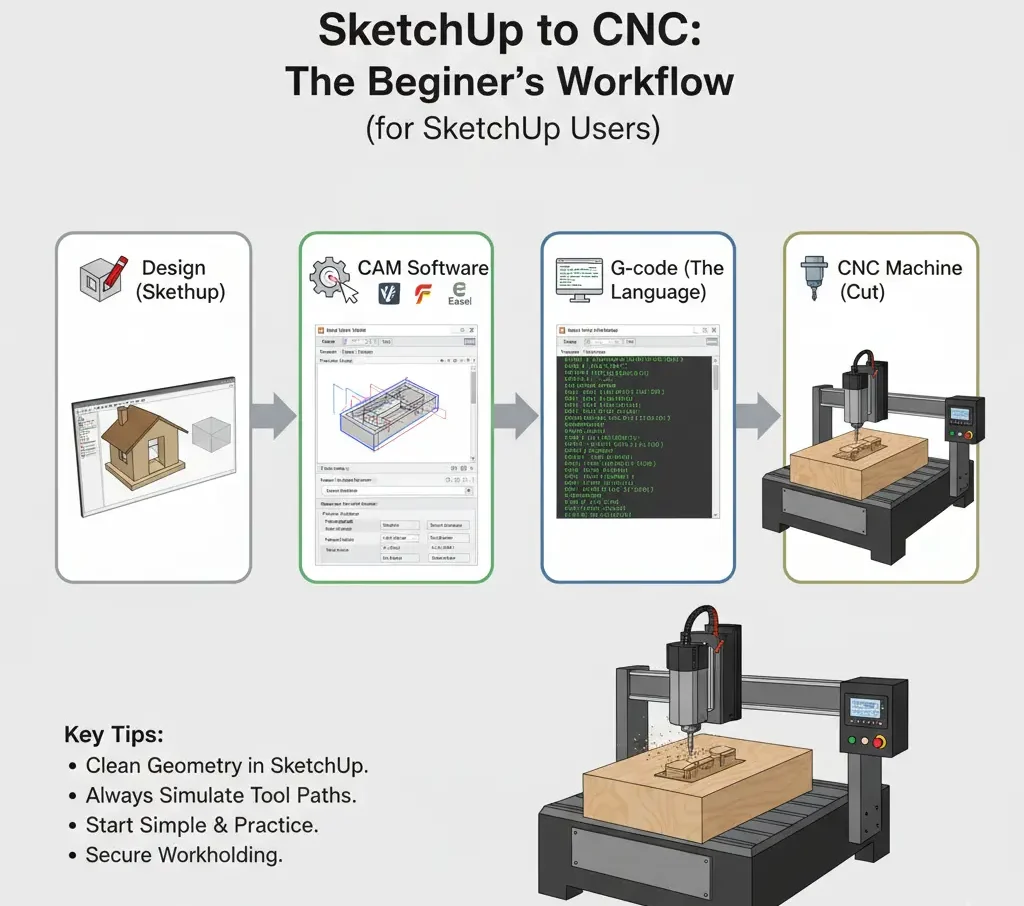Contractor Pricing Guide: Step-by-Step Formula for Small Jobs

Pricing small contractor jobs may not be the part of your day you’re most looking forward to. But it should be quick and easy. There’s no use spending 3 hours quoting a job that’ll take 2 hours to complete!
In this contractor pricing guide, we’re giving you a rock-solid formula to follow. We’ll walk you through the basic, must-know elements so you can charge your clients a fair and profitable price.
We’ll also share some real-world examples, tools to make the process quicker, and four mistakes you need to avoid.
Ready? It’s time to learn how to price contractor jobs.
The Basics of Contractors’ Pricing

There is so much more to pricing than adding up the cost of the materials you’ll need. If you do that, you’ll end up charging less than the job costs you to complete. That’s a recipe for low (or even non-existent) profitability!
There are also a few different strategies you can use when estimating contractor jobs. Let’s walk through the main pricing models.
Fixed Price (AKA Flat Rate)
With a fixed price, you give the client one number up front. If the job takes more time or more material than you expected, that’s on you. If you finish faster? More profit in your pocket.
Clients like this model because it’s predictable. You like it when you’re confident about the scope.
But fixed pricing requires careful planning. If you misjudge conditions or requirements, you shoulder the extra cost. So, use this for jobs with clear deliverables.
FROM ONE OF OUR PARTNERS — What Is a Flat Rate Price? (And Should You Offer It?)
Time and Materials (T&M)
With T&M, you bill for your actual time and the materials you use.
This model works well when the job’s open-ended or messy, like a remodel in a 1930s house where you won’t know what’s behind the walls until you open them.
You’ll need a reliable way to track hours and purchases, too. You’ll also need to set expectations early.
Some clients get uncomfortable if costs start creeping up without a cap. Consider including a “not to exceed” clause if you want to use T&M without compromising trust.
Cost-Plus
This one’s a hybrid approach. You tally up your direct job costs (materials, subcontractors, hours, etc.). Then, you tack on a percentage for your markup, usually 10% to 30%.
This works for bigger jobs where you value trust and transparency.
You’ll need detailed records and open communication. Clients are paying for access to your trade network and your project management. Show them it’s worth it.
What Are Overheads?
No matter which pricing model you go with, you have to factor in your overhead.
The Investopedia definition is this:
“Overhead is an ongoing business expense not directly attributed to creating a product or service.”
In other words, they are the costs that keep your business alive and breathing day in and day out.
Some examples include:
- Liability and workers’ compensation insurance
- Tool maintenance and replacement
- Admin time, like quoting, bookkeeping, and chasing invoices
- Marketing costs, including your website and social media
- Fuel and vehicle wear
- Phone and software
- Licensing and certifications
FROM ONE OF OUR PARTNERS — Operating Costs: Definition, Formula, and Examples
Why Overheads Matter (More Than You Think)
When you work for someone else, they buy the insurance and cover the truck. You clock in, clock out, and get paid. Simple.
But once you go solo or run your own business, they are your responsibility.
You don’t just need to cover what it costs to do the job. You need to cover what it costs to run the business.
Let’s say your overhead is $3,000 a month. If you’re pricing five jobs a month and not building that cost into each one, you’re leaving hundreds on the table.
Why Small Job Pricing Is Tricky for Contractors
Unlike a shelf price at the hardware store, contractor pricing doesn’t come with a barcode. If only it were that easy!
Instead, every job is a mix of time, cost, risk, and expectation. None of those elements are consistent or entirely predictable.
The biggest challenge is that pricing isn’t only about materials or hours. You’re also estimating how long the job will take, how clean the site is, and how much communication the client expects.
You’re forced to make an educated guess.
Other challenges include:
- Changing job scope. A minor task often expands once the work starts or when the client adds requests.
- Extra costs. Fuel, last-minute supply runs, extra materials, and travel time reduce your margin if you don’t include them.
- Client expectations. Some clients expect lower prices on small jobs, but that doesn’t mean the labor isn’t complex.
- Competitive pressure. Local contractors sometimes price too low, which affects how clients see your quote.
Pricing too low affects more than one job. It affects your business long-term. Here’s how the ripple effect plays out:
- You quote low to make the job appealing.
- The work takes longer than you budgeted.
- You earn less than you expected, or break even.
- Follow-up calls or extras eat into your next job.
- Bigger, better-paying jobs get pushed or rushed.
- You stay busy, but your profit doesn’t reflect your effort.
RELATED ARTICLE — 3 Elements of Strategic Pricing Every Contractor Should Know
Step-by-Step Contractor Pricing Formula

So, what’s the solution to these challenges?
An airtight contractor pricing guide. Use this formula to price almost any renovation or repair job. Whatever the size. Whatever the scope.
Step 1. Define the Scope in Writing
Before you crunch any numbers, get specific about what the job includes.
Write down the exact tasks. “Replace one 36″ bathroom vanity with plumbing hookup” is better than “vanity replacement.”
Make a note of who’s providing materials and who’s disposing of waste.
If the client says, “While you’re here, could you also…,” you can refer back to this scope and explain what’s extra.
Scope clarity builds trust and protects your time.
Step 2. Estimate Your Direct Costs
These are job-specific expenses, like:
- Materials. Price them with up-to-date supplier numbers.
- Labor. Use a realistic hourly rate (in the US, the average hourly rate of a contractor is $29.30).
- Subcontractors. If you’re bringing in a licensed electrician or plumber, get their rate in advance and include it in full.
For example, a job that requires $250 in materials and 3 hours of your time at $60/hour already puts your costs at $430. That’s before you add anything for overhead or margin.
Step 3. Add Overhead Costs
Speaking of overheads, don’t ignore these costs just because the job is small.
Instead, divide your total monthly overhead by your average number of jobs. Then add that figure to the total price.
Let’s say your overhead is $2,400 a month and you do 20 jobs. Add at least $120 per job to cover those fixed costs.
Step 4. Apply Your Profit Margin
Once you’ve added direct costs and overhead, layer your margin on top.
This is what you pay yourself for the risk and effort of running the business.
For small jobs, 20% to 40% margin is common. If the job involves high risk or premium service, go toward the higher end.
Step 5. Adjust for Market Factors
Now, pressure-test the price. Ask:
- Is this rate comparable to what other contractors in your area are charging?
- Is this job in a high-income zip code or a rural area with slower demand?
- Is the client likely to ask for changes, or are they easy to work with?
Sometimes you’ll raise or lower your number based on market signals. But you should never go below your true cost.
If you need to come down, consider removing non-essentials from the scope instead of discounting the whole job.
Step 6. Send the Real Number
If the total comes out to $713, leave it at $713.
Rounding it to $720 might seem like the right thing to do. But to the client, a round number can look made up. Specific numbers show you’ve done the math.
Then, send the estimate or quote in writing.
RELATED ARTICLE — Residential Construction Checklist: A Guide to Keep You on Track
Pricing Examples for Common Small Jobs

Let’s apply the pricing formula to two contractor pricing examples.
Example 1
Scope: Paint four walls and the ceiling in a 10×12 bedroom. Includes light patching and two coats. Client supplies the paint. You supply the rest.
Breakdown:
- Materials: $80 (use a paint cost calculator for an accurate estimate)
- Labor: $240 (6 hours at $40/hour)
- Overhead: $100 (fuel, insurance, admin, quoting time)
- Subtotal: $420
- Profit: $126 (30% margin)
- Final price: $546
Example 2
Scope: Install a tile backsplash between the countertop and cabinets. Includes surface preparation, installation, grout, trim, and seal. Client provides tile. You provide everything else.
Breakdown:
- Materials: $130 (grout, trim, tools, sealer, consumables, etc.)
- Labor: $360 (6 hours across 2 days—install on Day 1, grout and seal on Day 2)
- Overhead: $125
- Subtotal: $615
- Profit: $215 (35% margin)
- Final price: $830
What You Can Learn from These Examples
Here are the takeaways:
- Small jobs still need to include overhead costs. In the painting example, overhead and admin added $100 to a half-day job.
- In the backsplash example, splitting labor across two days raised the price. That’s to be expected. Setup and return trips take time.
- Using a set formula means you don’t need to rethink your process every time. You just add in the details and run the calculations.
Tools and Templates for Easier Contractor Pricing
There are a few tools that can make small job pricing faster and more consistent. Here’s what you can use to work smarter.
Job Estimating Software
Estimating software and apps let you build quotes using real costs, not rough guesses.
You input the job details, and it calculates the final price. You can save your standard markup, insert your overhead, and write estimates based on your own rates. Many tools also let you store past jobs and reuse them as templates.
If you’re already using software to send quotes or track invoices, look for a platform that combines those features. Some, like Joist, include estimating, invoicing, and payments in one spot.
Estimating tools are especially useful if:
- You do repeat work (like painting or flooring).
- You have a small team and need consistent pricing.
- You want quotes to look professional and go out faster.
Contractor Pricing Templates
Contractor pricing templates are fill-in-the-blank documents. You enter the materials, labor, travel, and any add-ons. The structure makes sure you don’t forget anything.
Some templates use spreadsheets. Others are included in software. Either way, they give you a repeatable wireframe to use.
Pricing Calculators
Calculators are tools that estimate costs based on square footage, materials, hourly rates, or job type. They’re not a full estimate, but they’re useful for quick planning.
The Benefits of Using Tools
Small jobs still take time to price. The right tools can speed things up. Benefits include:
- They save time by reusing data from past jobs.
- They reduce errors and missed line items.
- They keep your pricing consistent across your team.
- They let you quote jobs faster without losing quality.
- They make it easier to explain your pricing when clients ask questions.
4 Common Pricing Mistakes to Avoid

These are four mistakes contractors often make, along with ways to avoid them.
Mistake 1: Underestimating Labor Time
When preparation and cleanup aren’t included, the job always takes longer than planned.
How to avoid it: Estimate full labor time from start to finish. Use past job logs to track how long tasks usually take.
Mistake 2: Skipping Admin and Travel Costs
Quoting, driving, follow-ups, and paperwork all take time. But they rarely make an appearance in the estimate.
How to avoid it: Add a flat rate for admin and travel into your overhead. Apply it across every job, big and small.
Mistake 3: Letting the Client Set the Price
If you price the job based on what you think they’ll pay, you lose control of your margins.
How to avoid it: Use a fixed formula. Quote based on your direct costs, overhead, and margin.
Mistake 4: Forgetting Tool and Equipment Wear
Cutting blades, caulk guns, ladders, and other tools all break down with use. You’ll need to pay the cost later if you don’t plan for it now.
How to avoid it: Include a line for tool wear in your overhead. Spread that cost across every job throughout the month.
RELATED ARTICLE — How to Invoice as a Contractor
Master Home Renovation Contractor Pricing With These 3 Tips
Here’s what you can do now that you’ve finished our contractor pricing guide:
- Choose the pricing model that fits your job types. That could be fixed price, time and materials, or cost-plus.
- Calculate your monthly overhead and divide it across the average number of jobs you take.
- Tweak the pricing formula in this article to suit your workflows and local market.
Get Paid Anytime, Anywhere
You’ve got your pricing figured out, and now the job has been quoted, accepted, and completed. Next step? Let your clients pay how they want with Joist Payments. It’s the only integrated solution that gives you an easy, secure way to accept payments for invoices and estimates.














